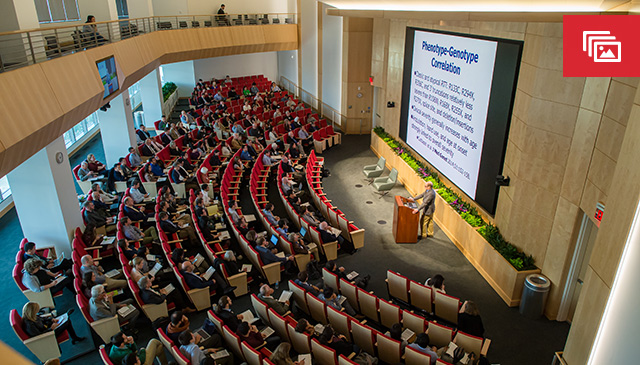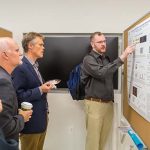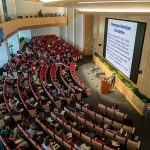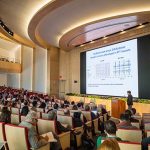
During the final week of October, Texas Children’s Hospital hosted visitors from around the world for a very special Rett Syndrome Symposium and Workshop.
The two-day event was momentous for many reasons. It was the inaugural meeting held in the stunning new Auditorium and Conference Center at the Jan and Dan Duncan Neurological Research Institute (Duncan NRI) at Texas Children’s Hospital. It fortuitously coincided with Rett Syndrome Awareness Month. And the symposium also marked the 20th anniversary of the discovery of the underlying cause of Rett syndrome. In 2000, NRI director Dr. Huda Zoghbi’s research team made the pioneering discovery that loss-of-function mutations in methyl-CpG binding protein, MECP2, were the underlying cause of Rett syndrome.
Rett syndrome is a rare neurological disorder that primarily affects young girls between 6 months and 2 years of age. The children appear to hit normal developmental milestones until, inexplicably, their motor, cognitive and social skills start to rapidly deteriorate. Most patients develop autistic features, breathing difficulties, dementia, growth abnormalities, epilepsy and scoliosis.
The symposium opened with a warm welcome from co-organizers Dr. Adrian Bird – Buchanan Professor of Genetics and Welcome Trust Center for Cell biology at the University of Edinburgh, UK – and Zoghbi, who is also a professor at Baylor College of Medicine and Howard Hughes Medical Institute investigator.
“The purpose of this event was to bring together researchers who work on Rett syndrome and leaders from related areas of neuroscience working in academia, industry and government, to think deeply and spark new ideas,” said Zoghbi. “The hope is that out of the work and discussions that happened here, in five years, when we’re marking the 25th anniversary of the gene discovery of Rett syndrome, we’ll also be celebrating new treatments for people with Rett syndrome.”
The international symposium was sponsored by Rettsyndrome.org (formerly the International Rett Syndrome Foundation) and the Rett Syndrome Research Trust. The multidisciplinary group of attendees included scientists, physicians, members of the lay public, and representatives from the National Institutes of Health, the pharmaceutical industry, and several foundations, all brought together to look at Rett syndrome with a fresh, new perspective.
On the first day of the symposium, presentation topics ranged from clinical observations of MECP2 disorders like Rett and MECP2 duplication syndrome to pathogenesis (progression or development) of Rett syndrome, to discussions on neuronal circuit alterations and therapeutics. Texas Children’s pediatric neurologist Dr. Bernhard Suter spoke about MECP2 duplication syndrome, which typically affects male patients and causes symptoms such as hypotonia, motor delays, intellectual disabilities, gastrointestinal issues and epilepsy.
Following a day of stellar research presentations, the investigators split into three working groups that focused on Molecular Pathogenesis, Therapeutic Approaches and Young Investigators. The groups discussed the information presented over the course of the day and their vision for the future of Rett syndrome research. This included the systemic and technical challenges that currently exist, and the group brainstormed ways to overcome those. The next morning, key points from these discussions were shared with the audience.
- Rett syndrome is a particularly challenging disorder to correct. The levels of MECP2 protein in the neurons need to be precisely regulated because too much MECP2 protein causes a different neurological condition, the MECP2 duplication syndrome. Despite these challenges, research in Rett syndrome is advancing at a rapid pace, having moved from gene discovery to promising clinical trials in under 20 years.
- Gene therapy offers exciting opportunities to develop treatment for Rett syndrome and is an area of active research. However, there are challenges to overcome including controlling the level and distribution of the delivered gene.
- While the ultimate long-term goal of researchers is to find a lasting cure using gene therapy, clinicians in the audience weighed in on the benefits of also developing short-term strategies to treat specific behavioral or motor issues and/or how to delay the age of symptom onset. This would be a huge step forward for patients, their families and caregivers who cope with this debilitating condition on a daily basis. Participants in the discussion also drew parallels to the field of breast cancer, where non-targeted treatment modalities serve as the workhorses to treat the majority of patients.
- There is a dire need to develop early screening/diagnostic methods for Rett syndrome among newborns. Early diagnosis, in combination with specialized therapies – such as neuromodulation physical therapy, speech therapy or psychotherapy may provide maximal improvements in the quality of life of the patients.
- Building collaborations between academia and industry, with a focus on multidisciplinary team science and data-sharing, is critical to facilitate the development of superior reagents (i.e., better viral vectors for gene therapy), biomarkers (i.e., meaningful measures of clinical outcomes) and therapies. Moreover, there was a general agreement that close partnerships between various key stakeholders, such as scientists, physicians, pharma/biotech industry, families, caregivers and advocacy groups, are crucial for developing effective therapies.
Learn more about Texas Children’s research efforts at the Jan and Dan Duncan Neurological Research Institute and world-class clinical expertise provided at the Rett Center.












